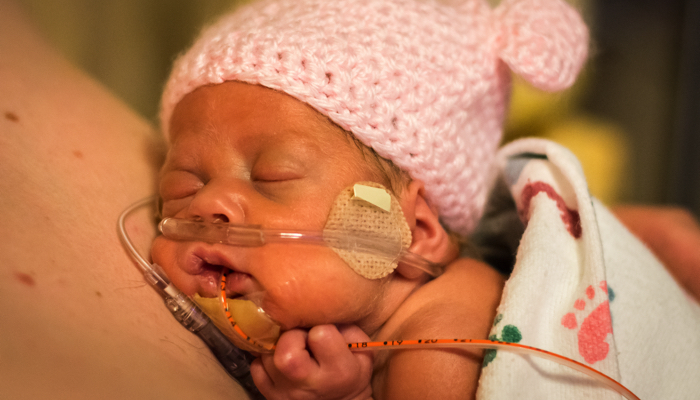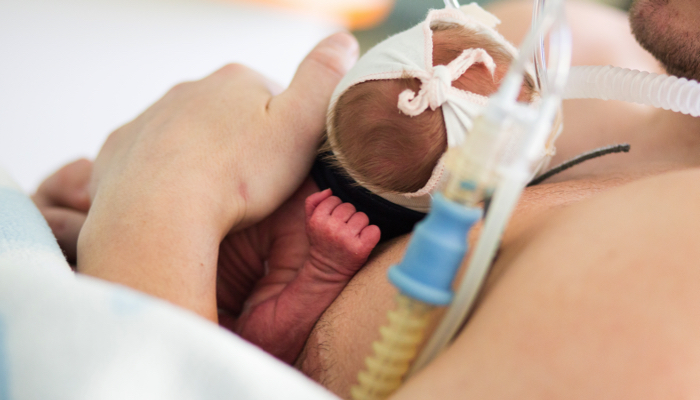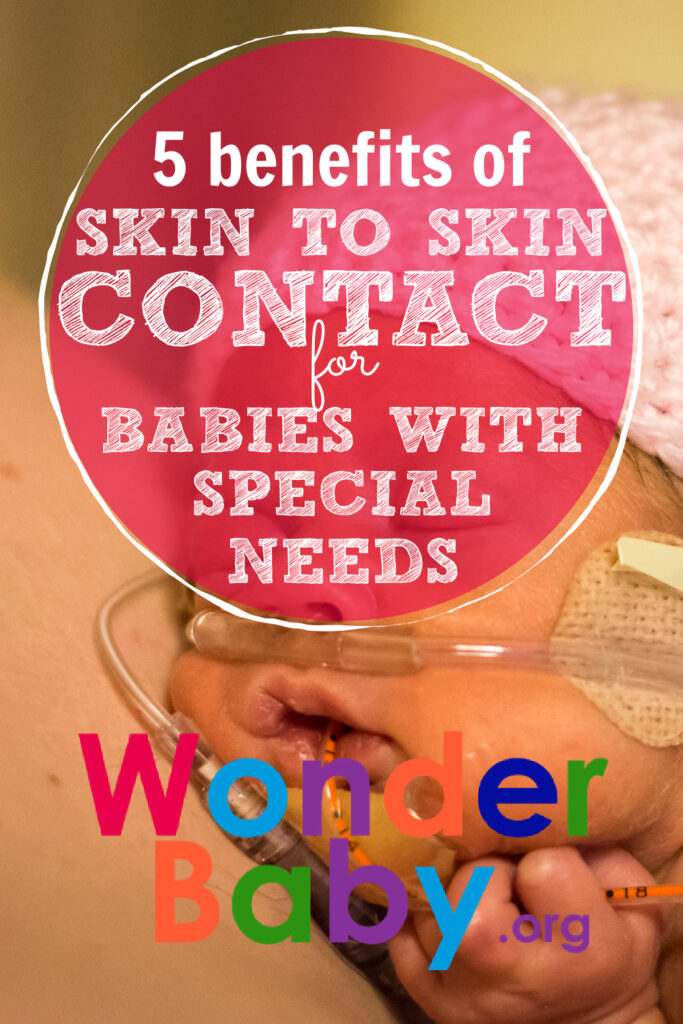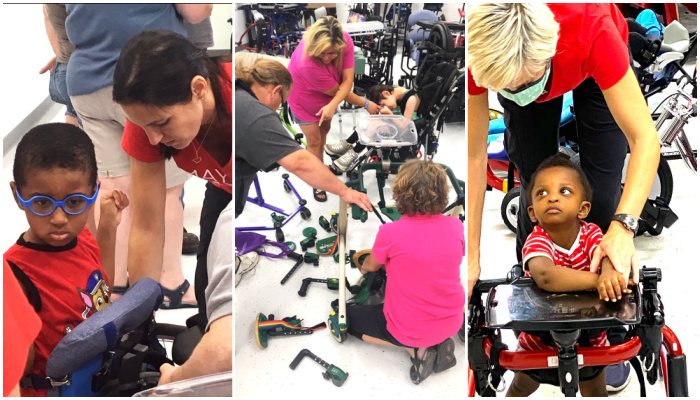5 Benefits of Skin-to-Skin Contact for Babies With Special Needs

The tremendous impact of skin-to-skin contact, often referred to as kangaroo care, is particularly important for babies born with special needs, such as premature babies, babies with disabilities, or babies in the NICU. These babies often have greater emotional needs and stress due to additional time in the hospital, pain or discomfort, and/or medical procedures.
Whether your baby was born at a low birth weight or has other unique needs, skin-to-skin contact establishes a close connection between you and your baby and provides a smoother transition from the comfortable, warm womb to their new world (Seitz, 2018). All areas of development are improved and nurtured through the miraculous, loving act of skin-to-skin contact.
Here’s an overview of five benefits of practicing skin-to-skin contact with your baby with special needs.
1. Better Understanding of Your Baby’s Needs
Through skin-to-skin contact, moms (and dads!) can better understand how to care for their baby. This close connection helps mothers distinguish their babies’ cries and respond accordingly. This is particularly helpful for babies who need special care and attention or are sickly and stressed. Responsive caregiving is essential for the health and development of your baby (Seitz, 2018).
Additionally, according to the Early Childhood Learning and Knowledge Center, “responsive caregiving allows you to observe and customize your interactions with children with suspected or identified disabilities or delays as you learn how to support them according to their individual needs” (Lytle, 2018).
2. Greater Weight Gain
Research overwhelmingly supports that skin-to-skin contact improves breastfeeding success. In fact, moms who regularly practice skin-to-skin contact are also more likely to breastfeed for a longer period of time. Due to these facts, babies also gain weight at a healthy pace, which aids in their overall development. This is specifically important for premature babies or babies born at a low birth weight (Seitz, 2018).
Skin-to-skin contact incentivizes breastfeeding because it stimulates the release of oxytocin, which boosts milk production and stimulates the desire to nurse. The close contact of skin-to-skin also makes it easier for moms to respond to their babies’ hunger cues and feed on demand, which is crucial for breastfeeding success and weight gain. The benefits of skin-to-skin contact, breastfeeding, and the immunity and nutrition in breast milk all work together to improve your baby’s health (Seitz, 2018).
3. Improved Brain Functioning and Attachment
When babies are safe, nestled skin-to-skin in their mother’s or primary caregiver’s arms, their energy is free to focus on learning and thriving. The signals in their brain communicate comfort and safety due to responsive caregiving, touch, and skin-to-skin contact. However, when babies are distressed, left unattended to cry, hungry, or cold, their energy and brain connections focus on body warmth and survival. Safety, comfort, and connection with their mama wires their brain one way, isolation, fear, and not having their basic needs met wires babies’ brains another way (Seitz, 2018).
What your baby craves most, whether they have unique needs or not, is connection and affection from you. Skin-to-skin contact helps a baby develop a close attachment to their parents or primary caregiver. Attachment is a crucial first step in healthy development and proper brain growth because it provides a sense of security. Above all else, babies want to feel safe, and because they are completely dependent on their parents, they feel safest when nestled close, skin-to-skin (Winston, 2016).

4. Less Stress and Discomfort
Skin-to-skin contact with your baby releases oxytocin, a hormone that makes you feel good. Higher levels of oxytocin contribute to lower levels of stress and anxiety, as well as lower blood pressure and heart rates for you and your baby (Dewar, 2021).
The stress hormone, cortisol, is measurably lower after just 20 minutes of skin-to-skin contact. This results in less crying, discomfort or pain, and a more peaceful environment (Seitz, 2018). For a baby who is in the NICU, undergoing any operations, or hooked up to machines in the hospital, skin-to-skin time helps to combat the added stressors.
According to the Cleveland Clinic, “skin-to-skin babies stay warmer and calmer, cry less, and have healthier blood sugar levels” compared to babies who are swaddled, kept in a crib, or incubator.
By understanding the benefits of oxytocin and what triggers its release, parents can be more intentional about the precious time they spend with their babies. Eye contact, communication, and touch all correspond with the total bonding experience and result in less stress and anxiety for babies and parents.
In addition, parents with babies who have unique needs also undergo extra stress and anxieties. Therefore, this special bonding time together becomes even more essential for the entire family.
5. More Sleep
Skin-to-skin contact promotes better sleep for your baby? According to Rebecca Michi, children’s sleep consultant, “Skin to skin contact is one of Mother Nature’s most powerful weapons … Human contact is one of the most essential forms of communication for us all. Now here’s the most amazing part: research has shown that babies (and parents) are not only happier when they engage in skin to skin sessions, but that the act can also help babies to sleep better.”
Sleep is important for everyone, especially for babies because their brain is growing so rapidly. According to Sanford Health, babies spend an “increased time in the very important deep sleep and quiet alert states” when they practice skin-to-skin contact. Deep sleep is crucial for healthy development.
Skin-to-skin contact results in longer naps, more peaceful sleep at night, and less crying. A more rested and healthy baby also means a more rested and less stressed you.
Even More Benefits of Skin-to-Skin Contact
While the above benefits are important, there is even more evidence that skin-to-skin contact is advantageous for babies with special needs.
Here’s a breakdown of the many benefits of skin-to-skin contact:
- It regulates your baby’s temperature, heart rate, and breathing patterns
- It strengthens the immune system
- It improves breastfeeding success by increasing mom’s milk supply, forming a stronger bond between mom and baby, and boosting the release of oxytocin
- It helps baby absorb and digest nutrients
- It decreases stress for you and your baby
- It improves your baby’s weight gain and growth
- It improves brain development and parental attachment, which has long-term benefits into adulthood
- It helps your baby conserve energy so they can focus on learning instead of surviving
- It fosters empathy and strengthens positive relationships
All of these incredible benefits work together to improve your baby’s health and bond with you.

How to Start Promoting Skin-to-Skin
Bonsie Skin to Skin Babywear is on a mission to educate all new and expecting parents about the incredible benefits of skin-to-skin contact. Our team at Bonsie wants every baby to have the best possible start to life, and we know that begins with a loving attachment between babies and their primary caregiver.
We make baby clothes with a purpose: to support your bond with your baby. Our babywear opens up at the chest so that you can easily practice skin-to-skin contact without undressing your baby. Simply open up the front of the Bonsie footie and nestle your baby so that their bare chest is touching your bare chest. Take a deep breath and relax as your baby falls peacefully asleep.
The reassuring weight of your baby on your chest, heartbeat to heartbeat, will soothe you both and establish an environment of peace, learning, and love.
@bonsiebaby Huge thanks to @lady_crady for seeing our story of Jane girl needing open heart surgery & sending us FOUR of these amazing @bonsiebaby outfits. They are so soft and so perfectly delicate over our Jane girl’s healing sternal incision. #tetralogyoffallot #heartwarrior #skintoskin #skintoskinbaby #babylove #babyhealth #babyfever #newbaby #newborn #attachment #babybonding #kangaroocare #momhealth #healthybaby #babyshower #babygifts #babyshowergifts #babysnuggles #babykisses #bonsiebaby #bonsie ♬ Miracle – Hopeful Ambient Piano Chords [Key of G] – Sodabelly
Helpful Resources
Dewar, G. (2021, May 31). Oxytocin affects social bonds and our responses to toxic stress. Can we influence oxytocin in children? Parenting Science. https://parentingscience.com/oxytocin-in-children-and-parents/
Lytle, S. (2020, April 14). Responsive Caregiving as an Effective Practice to Support Children’s Social and Emotional Development. Head Start: ECLKC.
Michi, R. (2022, January 9). How Skin to Skin Can Improve Baby Sleep. Children’s Sleep Consultant. https://childrenssleepconsultant.com/the-beauty-of-skin-to-skin/
Seitz, J. L. (2018, August 9). The Importance of Skin-to-Skin with Baby After Delivery. Sanford Health News. https://news.sanfordhealth.org/childrens/the-importance-of-skin-to-skin-after-delivery-you-should-know/ Winston, R., & Chicot, R. (2016, February 24). The importance of early bonding on the long-term mental health and resilience of children. London journal of primary care. https://www.ncbi.nlm.nih.gov/pmc/articles/PMC5330336/.

The information WonderBaby provides is not intended to be, and does not constitute, medical or other health advice or diagnosis and should not be used as such. Always consult with a qualified medical professional about your specific circumstances.
Related Posts

Special Needs
5 Spring Cleaning Tips for Families of Children with Disabilities
Spring cleaning is an opportunity to create a more accessible, organized, and supportive space for your child with disabilities. Declutter, deep clean, and refresh!

Visual Impairment
The Gift of Understanding: How a Young Child Helps His Blind Father Navigate Life
When a parent is blind, it’s natural for people to wonder how their sighted child will adapt. Will they struggle to understand their parent’s needs? Will they feel burdened by...

Assistive Technology, Support
May We Help: Engineering Independence for People with Disabilities
May We Help is dedicated to designing and building custom solutions that help individuals of all ages achieve mobility, access, and independence, all at no cost.